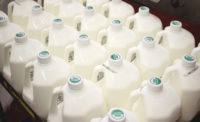As staffing continue to be a major challenge for dairy processors, one direction they can turn to is robotics and automation.
As Dairy Foods wrote last year, Baumer, Benchmark, Burkert Fluid Controls, FlexLink, Integrated Packaging Machinery, Stäubli and Texwrap are among the companies to offer robotics and automation in the dairy space.
To learn about the latest in this industry, Craig Souser, president and CEO, York, Pa.-based JLS Automation, which provides several hygienic robotic packaging solutions for the dairy industry and beyond, provides Dairy Foods with plenty of information about the market, taking it from a perspective of snacks for the dairy industry, as well as Roberto Marcos Perchin, business development manager, KPM Analytics, who focuses on a more macro dairy view.
We first asked Souser how robotics automation work for snacking and how it streamlines operations for a dairy processor. Robotics can handle the variety of cheese shapes and sizes on the primary side when loading items like string cheese into a thermoformer, he responded.
“Robotics will often dictate a ‘cleaner’ floorplan, which generally increases line efficiency. In addition, it will require careful SKU evaluation. Perhaps very short run or challenging items to handle are done on a fully manual line and higher running items are performed on a robotic line,” Souser noted.
Another potential benefit of robotics is the ability to help a human or replace one if labor concerns dictate. According to Souser, inspection errors can be greatly reduced with robotics/automation, as a camera’s eyes don’t get tired, and judgment is in no way subjective. Hence, variations from operator to operator are eliminated.
“It becomes much more predictable. They can be handled in a collaborative manner if there is a final inspection or touch-up operation needed. Ideally, the need for the human is eliminated,” Souser noted.
With technology always changing, the same statement can be made about robotics. How has it advanced in recent years and how has safety improved of robotic products?
“Sensing systems are much faster and more advanced. In addition, safety functions in PLC and controllers are often standard options or even built into the controllers,” JLS Automation’s CEO revealed.
What to consider when buying
When making the decision whether or not to purchase robotics/automation products in an effort to streamline their operations, JLS Automation strongly encourages processors to “walk before they run” to ensure that their experience is positive and doesn’t strain their support systems/people.
“There is often much excitement about eliminating a high count of labor inputs on a line on the primary side, but this could mean quite a few robots and if there is limited experience in supporting this technology, it can lead to struggles or worse,” Souser cautioned. “Starting with something like palletizing or case packing is a strategy that we promote.”
No matter what dairy processors decide regarding their purchasing decisions, expect to see a lot of new robotics/automation technology in the future.
Souser noted that machine learning algorithms are now being incorporated into vision and motion.
“This facilitates applications like sorting or grading, but also allows for much improved inspection. Combining that with automation of the packaging operation really drives the return on investment to another level,” Souser maintains. “We also see 3D becoming more of a factor for vision sensing. Again, facilitating inspection.
“A third area of advancement is gripper technology. Companies like Soft Robotics, Festo, and Piab are all offering elastomer-based fingers that allow for delicate handling and picking of otherwise very challenging products to pick,” Souser concluded. “In addition, we have been able to handle all the required SKUs with one tool given the versatility of the elastomer-based solutions.”
Areas dairy processors can consider automating
Nitrate and nitrite can react to secondary amines in the gastrointestinal tract to form potentially carcinogenic nitrosamines. That’s why it is important to test foodstuffs for these compounds, where they appear naturally and as an additive (preservative), said KPM Analytics' Perchin.
"In the case of milk — raw, pasteurized, treated, and powdered — a specific extraction routine with many steps is necessary prior to running the test. Most dairy processors do the extraction and testing manually and are missing an opportunity to automate."
When testing manually, dairy laboratories use one of two different methods, spectrophotometry or ion chromatography, he added. "Depending on the method, preparing a sample for testing involves many labor-intensive steps including warming, cooling, diluting, and filtering. These are followed by the steps of the test. All of these steps together are difficult to automate."
Many dairy processors have not adopted a less complex, automated testing method, Perchin continues. Laboratory equipment can automate the process, providing a simplified extraction step plus a complete automation.
"This method is well-established and fully normalized as ISO 14673-1 / IDF (International Dairy Federation) 189-1:2004," Perchin concludes. "Automated equipment like the FUTURA console from KPM Analytics can easily handle a typical volume, which may be 300 to 500 samples per day."
Photo courtesy of JLS Automation




